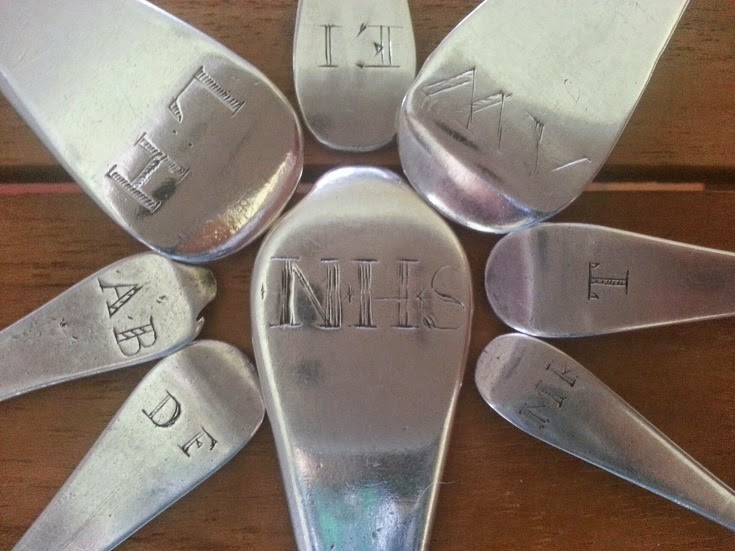 |
| Maker's mark of John Ladyman |
John Ladyman married Sarah Wilson on September 27, 1691 at St. James church in Duke's Place, London (Phillimore 39). As far as I can interpret from The Transcripts of the Registers of the United Parishes of S. Mary Woolnoth and S. Mary Woolchurch haw, John and Sarah had six children:
- Elizabeth, baptized April 29, 1692 (based on the date of the marriage and Elizabeth's baptismal date, does this mean Sarah was pregnant when she married John?);
- John, baptized November 5, 1693 and died on January 31, 1694;
- Mary, baptized November 19, 1695;
- Thomas, baptized June 10, 1697;
- John, the only entry being that he was the "infant and son" of John Ladyman who died on November 10, 1697 and was buried on November 11; and
- John, baptized January 6, 1699
(Brooke and Hallen 77, 78, 80, 82, 85, 260, 264)
Since there is not a separate entry for the baptism of the John who died on November 10, 1697, I assume he was born and died the same day. These entries also make me wonder how quickly after birth children at this time were baptized; take for instance the first John who was baptized just over 6 months after Elizabeth, implying - only if John was baptized very quickly after his birth - that Elizabeth was born at least three months before her baptism. Same query with the birth-baptism intervals of Thomas and the second John. Of course, there could also have been errors in the original registers or they could have occurred during transcription. I am unable to find a record of John Ladyman's death.
 |
| Five gold teaspoons by John Ladyman, 1711, along with sixth teaspoon, sugar nips and mote spoon, Dublin post-1730. Photograph credit: The Metropolitan Museum of Art, Gift of Mrs. Edward S. Harkness, 1927. www.metmuseum.org |
The most interesting pieces by John Ladyman that I have come across are a set of five teaspoons made of gold dating to 1711 in the collection of the Metropolitan Museum of Art. The five Ladyman teaspoons are shown with another later teaspoon, a mote spoon, and a pair of sugar nips all made of gold and all made in Dublin post-1730. Each piece is engraved with a K surmounted by an earl's coronet, which the museum states could possibly be for the Earl of Kerry, a title created in 1722. Now, if there are five of these gold teaspoons, a sixth presumably existed at some point, since a half-dozen was the norm. What happened to this sixth gold spoon? Who commissioned John Ladyman to make these golden teaspoons in the first place? If the MMA is correct and the engraving is for the Earl of Kerry, the engraving cannot be contemporary to the manufacture of the 1711 Ladyman teaspoons. Was there an original engraving on the backs of the teaspoons that would have given us a clue to their first owner?
 |
| Gold teaspoon by John Ladyman, 1711. Photograph credit: The Metropolitan Museum of Art, Gift of Mrs. Edward S. Harkness, 1927. www.metmuseum.org |
To date, my small collection of pieces by him includes three tablespoons, six dessert spoons, and two teaspoons, all in the Hanoverian rattail style.
 |
| Front and back of three tablespoons, 1712, two (of a set of six) dessert spoons, 1702, and two teaspoons, all by John Ladyman |
 |
| Engravings on the terminals of John Ladyman spoons |
Sources:
Brooke, J.M.S. and Hallen, A.W.C. The Transcript of the Registers of S. Mary Woolnoth and S. Mary Woolchurch, haw, in the City of London, from their
Commencement 1538 to 1760. London: Bowles & Sons, 1886. Google Books. Web. 11 Oct 2014.
Phillimore, W.P.W. and Cokayne, George E., eds. London Parish Registers. Marriages at St. James's , Duke's Place, From 1691 to 1700. Vol. III. London: Phillimore
& Co., 1901. Internet Archive. Web. 11 Oct 2014.







